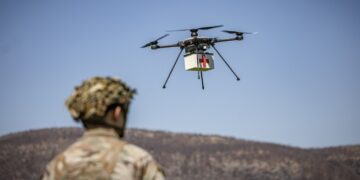A military drone operating near China’s Hainan Island presented itself as a British Typhoon fighter jet on flight-tracking systems. Experts state that this incident has heightened concerns over ADS-B system manipulation and potential espionage attempts.
Flight-tracking services recently recorded a remarkable event in Chinese airspace. A military aircraft conducting a routine flight around China’s Hainan Island broadcast signals identifying itself as a Typhoon fighter jet (e.g., ZK334) belonging to the Royal Air Force (RAF). Although the aircraft transmitted the identity of a British military jet together with the call code YILO2400, its flight profile was entirely different from that of a fast combat aircraft.
Flight Data Points to a Drone

Analyses showed that the speed and altitude data of the broadcasting aircraft did not exhibit the rapid acceleration, steep climb rates, or sharp maneuvers required of a high-performance jet like the Typhoon.
The data revealed a slow and stable movement pattern, more indicative of a medium-altitude reconnaissance or surveillance Chinese drone. The aircraft ended its flight by landing in an area on Hainan Island known for dense Chinese military drone activity.
This situation clearly showed that on civilian flight-tracking services (such as FR24), a Chinese platform was using a British military identity that it should not have been broadcasting.
ADS-B System Vulnerability: Easy Manipulation
According to experts, this incident once again brings to the forefront a core vulnerability of the ADS-B (Automatic Dependent Surveillance–Broadcast) system, which broadcasts aircraft positions. ADS-B manipulation can be carried out easily because the system lacks any identity-authentication mechanism to verify the transmitted identity.
This technical reality means that any aircraft capable of manually entering data into its transponder can broadcast the identity of a completely different platform — in this case, a British Typhoon.
Unclear Intent: Test or Espionage?
According to the report by the UK Defence Journal, there is no definitive explanation as to why the Chinese platform used the identity of a foreign military jet. Possible purposes include:
- Testing identity-masking technologies and conducting an experiment.
- A deliberate attempt at ADS-B system manipulation and deception.
- Misconfiguration of the transponder of a drone in training or testing phase.
The incident serves as an important warning for the global defense and aviation communities: instead of blindly trusting flight-tracking data, it is necessary to verify information and increase awareness of identity-manipulation risks.
SOURCE: C4Defence






























